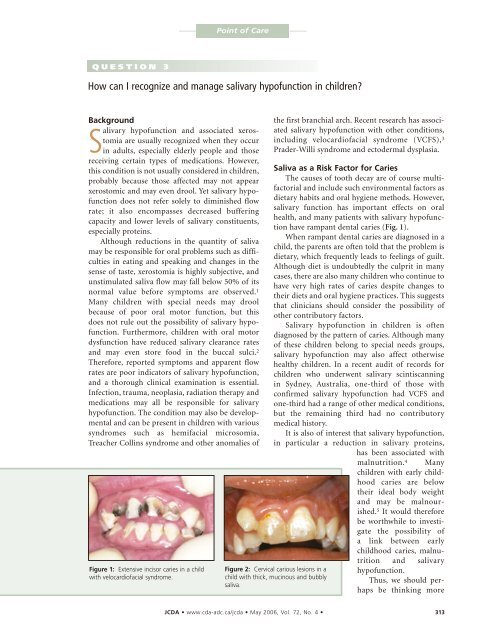JCDA - Canadian Dental Association
JCDA - Canadian Dental Association
JCDA - Canadian Dental Association
Create successful ePaper yourself
Turn your PDF publications into a flip-book with our unique Google optimized e-Paper software.
QUESTION 13<br />
–––– Point of Care ––––<br />
How can I recognize and manage salivary hypofunction in children?<br />
Background<br />
Salivary hypofunction and associated xerostomia<br />
are usually recognized when they occur<br />
in adults, especially elderly people and those<br />
receiving certain types of medications. However,<br />
this condition is not usually considered in children,<br />
probably because those affected may not appear<br />
xerostomic and may even drool. Yet salivary hypofunction<br />
does not refer solely to diminished flow<br />
rate; it also encompasses decreased buffering<br />
capacity and lower levels of salivary constituents,<br />
especially proteins.<br />
Although reductions in the quantity of saliva<br />
may be responsible for oral problems such as difficulties<br />
in eating and speaking and changes in the<br />
sense of taste, xerostomia is highly subjective, and<br />
unstimulated saliva flow may fall below 50% of its<br />
normal value before symptoms are observed. 1<br />
Many children with special needs may drool<br />
because of poor oral motor function, but this<br />
does not rule out the possibility of salivary hypofunction.<br />
Furthermore, children with oral motor<br />
dysfunction have reduced salivary clearance rates<br />
and may even store food in the buccal sulci. 2<br />
Therefore, reported symptoms and apparent flow<br />
rates are poor indicators of salivary hypofunction,<br />
and a thorough clinical examination is essential.<br />
Infection, trauma, neoplasia, radiation therapy and<br />
medications may all be responsible for salivary<br />
hypofunction. The condition may also be developmental<br />
and can be present in children with various<br />
syndromes such as hemifacial microsomia,<br />
Treacher Collins syndrome and other anomalies of<br />
Figure 1: Extensive incisor caries in a child<br />
with velocardiofacial syndrome.<br />
the first branchial arch. Recent research has associated<br />
salivary hypofunction with other conditions,<br />
including velocardiofacial syndrome (VCFS), 3<br />
Prader-Willi syndrome and ectodermal dysplasia.<br />
Saliva as a Risk Factor for Caries<br />
The causes of tooth decay are of course multifactorial<br />
and include such environmental factors as<br />
dietary habits and oral hygiene methods. However,<br />
salivary function has important effects on oral<br />
health, and many patients with salivary hypofunction<br />
have rampant dental caries (Fig. 1).<br />
When rampant dental caries are diagnosed in a<br />
child, the parents are often told that the problem is<br />
dietary, which frequently leads to feelings of guilt.<br />
Although diet is undoubtedly the culprit in many<br />
cases, there are also many children who continue to<br />
have very high rates of caries despite changes to<br />
their diets and oral hygiene practices. This suggests<br />
that clinicians should consider the possibility of<br />
other contributory factors.<br />
Salivary hypofunction in children is often<br />
diagnosed by the pattern of caries. Although many<br />
of these children belong to special needs groups,<br />
salivary hypofunction may also affect otherwise<br />
healthy children. In a recent audit of records for<br />
children who underwent salivary scintiscanning<br />
in Sydney, Australia, one-third of those with<br />
confirmed salivary hypofunction had VCFS and<br />
one-third had a range of other medical conditions,<br />
but the remaining third had no contributory<br />
medical history.<br />
It is also of interest that salivary hypofunction,<br />
in particular a reduction in salivary proteins,<br />
has been associated with<br />
malnutrition. 4 Many<br />
children with early childhood<br />
caries are below<br />
their ideal body weight<br />
and may be malnourished.<br />
5 It would therefore<br />
be worthwhile to investigate<br />
the possibility of<br />
a link between early<br />
childhood caries, malnu-<br />
Figure 2: Cervical carious lesions in a<br />
child with thick, mucinous and bubbly<br />
saliva.<br />
trition and salivary<br />
hypofunction.<br />
Thus, we should perhaps<br />
be thinking more<br />
<strong>JCDA</strong> • www.cda-adc.ca/jcda • May 2006, Vol. 72, No. 4 • 313

















